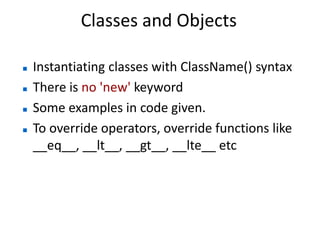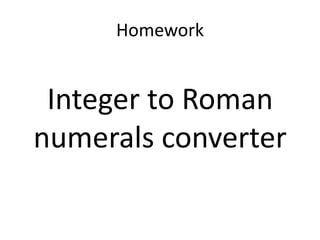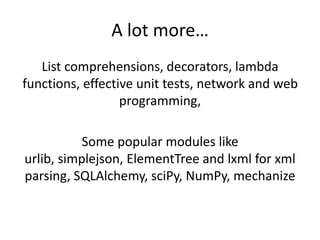Python Workshop - Learn Python the Hard Way
- 1. Learn Python The Hard Way Utkarsh Sengar Contents taken from © Copyright 2010, Zed A. Shaw.
- 2. Resources • Learn Python The Hard Way, 2nd Edition – http://bit.ly/python-lug (Free online) – Paperback book costs $15.99 – http://learncodethehardway.org • Google python class: – http://code.google.com/edu/languages/google- python-class/ • MIT Open courseware: – http://academicearth.org/courses/introduction-to- computer-science-and-programming
- 3. It’s Easy. 5 most important things: – Do Not Copy-Paste – Code – Practice – Practice – Practice
- 4. Prerequisites Python v2.5 + python Any text editor. gEdit (Linux) TextMate (OSX) Settings Tabs Width: 4 Insert spaces instead of tabs Your Mind.
- 5. TODO: today Total of 52 chapters We will cover: 1-22, 28-35, 39-42 Basic constructs, data structures, OOP Solve two simple python problems. Homework: Another problem. What did you think?
- 6. Lets code….. etherPad http://ip-address:9001
- 7. But first……..Pip, pep8, iPython • pip install simplejson – For python packages in Python package index • pep8 script.py – Python style guide. Your best friend • Python Easter egg – import this • Ipython • Open pydocs : docs.python.org/library/index.html
- 8. comments Single line comments only '#' (an octothorpe) notifies beginning Ends with a newline
- 9. Printing statements print is builtin function Usage: print ”Hello, world!” Appends a newline automatically To avoid new line, use a comma (,) Usage: print ”Hello”, print ”roopesh”
- 10. Basic math * / % + - < > <= >= Same as C operator precedence / does a integer division Example: print "Hens", 25 + 30 / 6 print 3 + 2 + 1 - 5 + 4 % 2 - 1 / 4 + 6 print "What is 5 - 7?", 5 – 7 print "Is it greater or equal?", 5 >= -2
- 11. More operators • Basic ones: + - * / % • Try: – x // y – abs(x) – int(x), long(x), float(x) – complex(re, im) – c.conjugate() – pow(x, y) or x ** y
- 12. variables No need of types Duck typing cars = 100 space_in_car = 4.0 result = cars + space_in_car cars_not_driven = cars Can assign one var to another Tip: type(cars)
- 13. Variables and printing Can use placeholders in print statements print ”let's talk about %s” % my_name print "There are %d types of people." % 10 print "Those who know %s and those who %s." % (binary, do_not) Also can use names for placeholders print ”my name is %(name)s” % {'name': my_name}
- 14. Text (String) There are 3 types of notation Single quotes, double quotes, multiline text Multiline text stores the text, whitespaces and escape characters as well val = ’hello world’ val = ”hello again!” val = ”Hello n World !!” val = ”””no need to ’escape’ anything – ”ok?” ””” Interesting functions: upper(), lower(), title(), swapcase(),strip()
- 15. Booleans True and False Can use in print with placeholders as well Anything that has a value is true, anything like 0, zero length string, zero length list or dictionary is false val = ’Hi my friend’ if val: print ”yo!” If ’Hi’ in val: print ’this keeps getting better!’
- 16. Input There are two functions: input(), raw_input() raw_input() contains string and input() could contain object first = raw_input("Please enter your age ") second = input("Please enter your age again") print "You said you are", first print "Then you said you are", second Try again, pass 40+2 in second
- 17. Working with python prog files Any arguments passed to python prog files is stored in argv Zero based arguments, first one is always script name import sys print sys.argv[0] print sys.argv[1] Run: python file.py 4
- 18. Working with files open(filename, mode) : returns file handle read() : to read the whole file readline() and readlines(): to read each line write(data) : writes to file close() : to close the file handle from sys import argv script, filename = argv txt = open(filename, 'r+') #r or w print "Here's your script %r:" % script print "Here's your file %r:" % filename print txt.read() txt.write('42') txt.close()
- 19. functions def keyword to declare a function Arguments don't need function type Can skip return value No return implies it returns a None value Always do: x is None and not, x == None None is similar to null To take unlimited number of arguments: use *arg as argument, it is packing method for arguments
- 20. functions cont… def print_none():pass def print_one(arg1): print ”got one arg: %s” % arg1 def print_two(arg1, arg2): print ”got two args: %s, %s” %(arg1, arg2) def print_two_2(*args): print args return args
- 21. Logics and, or, not, ==, !=, >, >=, <, <= and returns last value which makes the statement true or returns first value which makes the statement false Both are short-circuit operator test = True result = test and 'Test is True' or 'Test is False'
- 22. Data Structures List: [1, 2, 3, 2] Tuples: (1, 2, 3, 2) Set: {1,2,3} Dictionary: {’name’ : ’utkarsh’, ’age’ : 42}
- 23. Lists and loops Lists: [1, 2, 3] append(elem), extend(list), insert(idx, elem), rem ove(x), pop(i), count(i), sort(), reverse(),len(l) Tuples: (1, 2, 3) Difference: lists are mutable, tuples are immutable Ideally lists should have same data types
- 24. Lists and loops for element in list: print element for i in range(i): print i for i, val in enumerate(list): print i, val sorted_list = sorted(list) sort(list) List comprehensions for ease of use (later..)
- 25. Lists and loops Lists from strings: a = ”A B C D E F”.split() #['A', 'B', 'C', 'D', 'E', 'F’] a.pop() ' '.join(a) #joins lists to form a string List slicing: list[start:end] a[0:len(a)] a[:4] a[3:] a[-1]
- 26. Dictionaries {'name': 'Roopesh’, ’age’ : 42} Key-value pairs / lookup table Can be accessed with a['name'] Can add new values with same syntax a['city'] = 'San Jose' Can remove an item with 'del' del a['city'] Add a bunch using: dict.update(another_dict)
- 27. Classes and Objects Class keyword, inherits from object Constructor: def __init__ All methods take first arg as the instance of class Denoted with word 'self' Any number of args have to follow self def func(self, val)
- 28. Classes and Objects Instantiating classes with ClassName() syntax There is no 'new' keyword Some examples in code given. To override operators, override functions like __eq__, __lt__, __gt__, __lte__ etc
- 29. Class example class MyClass: answer = 42 def a_method(self): print “I am a method” instance = MyClass () instance.a_method() hasattr(MyClass, “answer”)
- 30. List comprehensions (bonus) [each for each in range(100) if each % 2 == 0] [some_func(each) for each in range(100)] iter(list) produces a list iterator Gives ability to get next item with iterator.next() When iterator gets exhausted, it produces StopIteration exception
- 31. Handling Exceptions Try: … do some handling except Error as e: print e finally: … do some final clean up
- 32. Problem 1 Write a function char_freq() that takes a string and builds a frequency listing of the characters contained in it. Represent the frequency listing as a Python dictionary. Try it with something like char_freq("abbabcbdbabdbdbabababcbcbab”)
- 33. Problem 2 In cryptography, a Caesar cipher is a very simple encryption techniques in which each letter in the plain text is replaced by a letter some fixed number of positions down the alphabet. For example, with a shift of 3, A would be replaced by D, B would become E, and so on. The method is named after Julius Caesar, who used it to communicate with his generals. ROT-13 ("rotate by 13 places") is a widely used example of a Caesar cipher where the shift is 13. In Python, the key for ROT-13 may be represented by means of the following dictionary: key = {'a':'n', 'b':'o', 'c':'p', 'd':'q', 'e':'r', 'f':'s', 'g':'t', 'h':'u', 'i':'v', 'j':'w', 'k':'x', 'l':'y', 'm':'z', 'n':' a', 'o':'b', 'p':'c', 'q':'d', 'r':'e', 's':'f', 't':'g', 'u':'h', 'v':'i', 'w':'j', 'x':'k', 'y':'l', 'z':'m', 'A':'N', ' B':'O', 'C':'P', 'D':'Q', 'E':'R', 'F':'S', 'G':'T', 'H':'U', 'I':'V', 'J':'W', 'K':'X', 'L':'Y', 'M':'Z', 'N':'A' , 'O':'B', 'P':'C', 'Q':'D', 'R':'E', 'S':'F', 'T':'G', 'U':'H', 'V':'I', 'W':'J', 'X':'K', 'Y':'L', 'Z':'M'} Your task in this exercise is to implement an encoder/decoder of ROT-13. Once you're done, you will be able to read the following secret message: Pnrfne pvcure? V zhpu cersre Pnrfne fnynq!
- 34. Homework Integer to Roman numerals converter
- 35. Want more? • Go here: – 15 Exercises to Know A Programming Language: Part 1 – http://www.knowing.net/index.php/2006/06/16/ 15-exercises-to-know-a-programming-language- part-1
- 36. A lot more… List comprehensions, decorators, lambda functions, effective unit tests, network and web programming, Some popular modules like urlib, simplejson, ElementTree and lxml for xml parsing, SQLAlchemy, sciPy, NumPy, mechanize
- 37. At the end…… “I'll say that learning to create software changes you and makes you different. Not better or worse, just different.” “The world needs more weird people who know how things work and who love to figure it all out.” ~ Zed Shaw Source: http://learnpythonthehardway.org/book/advice.html
















![Working with python prog files
Any arguments passed to python prog files is
stored in argv
Zero based arguments, first one is always
script name
import sys
print sys.argv[0]
print sys.argv[1]
Run: python file.py 4](https://image.slidesharecdn.com/lpthw-111105192858-phpapp01/85/Python-Workshop-Learn-Python-the-Hard-Way-17-320.jpg)




![Data Structures
List: [1, 2, 3, 2]
Tuples: (1, 2, 3, 2)
Set: {1,2,3}
Dictionary: {’name’ : ’utkarsh’, ’age’ : 42}](https://image.slidesharecdn.com/lpthw-111105192858-phpapp01/85/Python-Workshop-Learn-Python-the-Hard-Way-22-320.jpg)
![Lists and loops
Lists: [1, 2, 3]
append(elem), extend(list), insert(idx, elem), rem
ove(x), pop(i), count(i), sort(), reverse(),len(l)
Tuples: (1, 2, 3)
Difference:
lists are mutable,
tuples are immutable
Ideally lists should have same data types](https://image.slidesharecdn.com/lpthw-111105192858-phpapp01/85/Python-Workshop-Learn-Python-the-Hard-Way-23-320.jpg)

![Lists and loops
Lists from strings:
a = ”A B C D E F”.split()
#['A', 'B', 'C', 'D', 'E', 'F’]
a.pop()
' '.join(a) #joins lists to form a string
List slicing: list[start:end]
a[0:len(a)]
a[:4]
a[3:]
a[-1]](https://image.slidesharecdn.com/lpthw-111105192858-phpapp01/85/Python-Workshop-Learn-Python-the-Hard-Way-25-320.jpg)
![Dictionaries
{'name': 'Roopesh’, ’age’ : 42}
Key-value pairs / lookup table
Can be accessed with a['name']
Can add new values with same syntax
a['city'] = 'San Jose'
Can remove an item with 'del'
del a['city']
Add a bunch using: dict.update(another_dict)](https://image.slidesharecdn.com/lpthw-111105192858-phpapp01/85/Python-Workshop-Learn-Python-the-Hard-Way-26-320.jpg)



![List comprehensions (bonus)
[each for each in range(100) if each % 2 == 0]
[some_func(each) for each in range(100)]
iter(list) produces a list iterator
Gives ability to get next item with
iterator.next()
When iterator gets exhausted, it produces
StopIteration exception](https://image.slidesharecdn.com/lpthw-111105192858-phpapp01/85/Python-Workshop-Learn-Python-the-Hard-Way-30-320.jpg)






